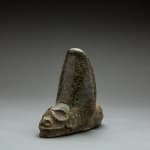Taino Stone Trigonolitos, 1100 CE - 1500 CE
Stone
16.3 x 14 cm
6 3/8 x 5 1/2 in
6 3/8 x 5 1/2 in
AM.0079
Further images
This small-scale trigonolitos, or three-pointer, represents a popular art form among the Taino. This culture flourished in the Caribbean between c.1200-1500, before the Spanish conquest disrupted its existence. The precise...
This small-scale trigonolitos, or three-pointer, represents a popular art form among the Taino. This culture flourished in the Caribbean between c.1200-1500, before the Spanish conquest disrupted its existence. The precise function of these triangular objects is unknown although it is clear that they were used for ceremonial purposes. Although the Caribbean islands had been populated for centuries before the Taino heyday, a new level of political organisation was achieved during this period. Three-pointers, along with stone collars and elbow stones, were owned by the caciques or chieftains as symbols of their power. The central cone of these triangular objects has been interpreted in a variety of ways. Suggestions include manioc shoots (one of the main crops of the Taino), volcanoes, the roofs of Taino houses, phalluses and the human breast. None of these theories has been universally accepted and the precise origins of the shape are likely to remain a mystery. Despite this, many scholars agree that these ceremonial objects were symbols of power and fertility. This seems to be supported by a letter written by Columbus in which he reports on his findings among the Taino, ‘Equally the majority of caciques (chiefs) have three stones to which they and their people have great devotion. One they say is for the fertility of the grain and vegetables that they grow; the next for mothers to give birth without pain, and the third for the water and sun when they have need.’
Both ends of this example are carved in the form of a zoomorphic face. It was a fairly common practice amongst Taino craftsmen to combine multiple representations of anthropomorphic or zoomorphic figures on the same object, often arranged in such a way that both faces are not visible from the same angle. The religious or spiritual significance of such objects cannot be precisely defined in the absence of a written tradition. The Taino believed in the existence of a supreme god or creator called Yucahu Maorocoti and a fertility goddess called Attabeira. Ancestor worship was also fundamental to their belief system. Images of the gods and spirits were created in wood, bone, shell and stone and are referred to collectively as zemis. This example clearly had spiritual associations for its first owner and our inability to define them closely only contributes to its sense of mystery.
Both ends of this example are carved in the form of a zoomorphic face. It was a fairly common practice amongst Taino craftsmen to combine multiple representations of anthropomorphic or zoomorphic figures on the same object, often arranged in such a way that both faces are not visible from the same angle. The religious or spiritual significance of such objects cannot be precisely defined in the absence of a written tradition. The Taino believed in the existence of a supreme god or creator called Yucahu Maorocoti and a fertility goddess called Attabeira. Ancestor worship was also fundamental to their belief system. Images of the gods and spirits were created in wood, bone, shell and stone and are referred to collectively as zemis. This example clearly had spiritual associations for its first owner and our inability to define them closely only contributes to its sense of mystery.





